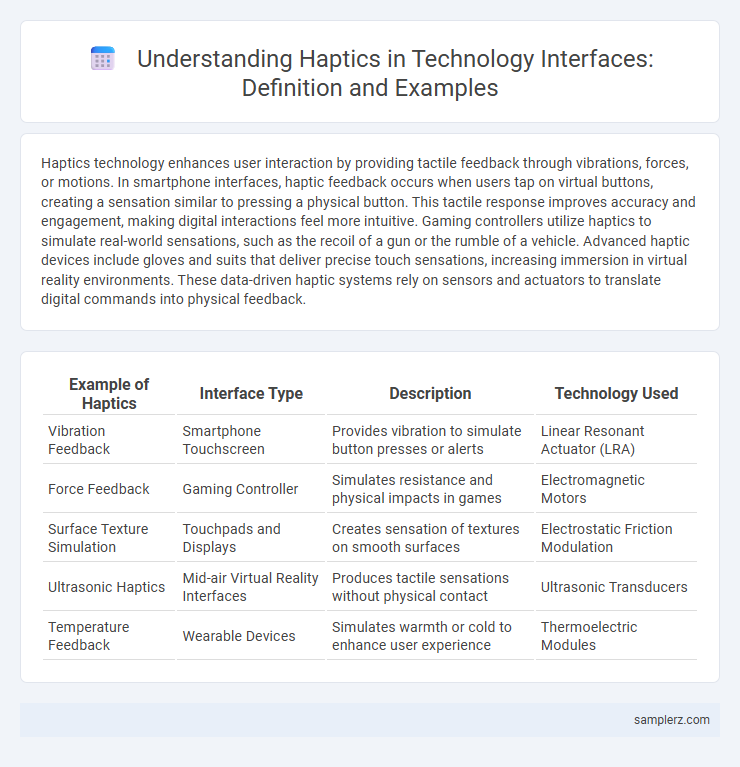Haptics technology enhances user interaction by providing tactile feedback through vibrations, forces, or motions. In smartphone interfaces, haptic feedback occurs when users tap on virtual buttons, creating a sensation similar to pressing a physical button. This tactile response improves accuracy and engagement, making digital interactions feel more intuitive. Gaming controllers utilize haptics to simulate real-world sensations, such as the recoil of a gun or the rumble of a vehicle. Advanced haptic devices include gloves and suits that deliver precise touch sensations, increasing immersion in virtual reality environments. These data-driven haptic systems rely on sensors and actuators to translate digital commands into physical feedback.
Table of Comparison
| Example of Haptics | Interface Type | Description | Technology Used |
|---|---|---|---|
| Vibration Feedback | Smartphone Touchscreen | Provides vibration to simulate button presses or alerts | Linear Resonant Actuator (LRA) |
| Force Feedback | Gaming Controller | Simulates resistance and physical impacts in games | Electromagnetic Motors |
| Surface Texture Simulation | Touchpads and Displays | Creates sensation of textures on smooth surfaces | Electrostatic Friction Modulation |
| Ultrasonic Haptics | Mid-air Virtual Reality Interfaces | Produces tactile sensations without physical contact | Ultrasonic Transducers |
| Temperature Feedback | Wearable Devices | Simulates warmth or cold to enhance user experience | Thermoelectric Modules |
Introduction to Haptic Interfaces in Technology
Haptic interfaces use tactile feedback to enhance user interaction by simulating touch sensations through vibrations, forces, or motions. These technologies are commonly implemented in smartphone touchscreens, gaming controllers, and virtual reality systems to provide realistic and immersive experiences. By translating digital signals into physical sensations, haptic interfaces improve usability and accessibility in diverse technological applications.
Smartphone Tactile Feedback Applications
Smartphone tactile feedback applications utilize haptics technology to enhance user interaction by providing precise vibration patterns that simulate touch sensations. These applications include keyboard feedback, where subtle taps improve typing accuracy, and gaming interfaces that deliver realistic force feedback to increase immersion. Advanced haptic engines like Apple's Taptic Engine enable nuanced textures and alerts, significantly improving user experience in mobile interfaces.
Haptics in Virtual Reality Controllers
Haptics in virtual reality controllers provide precise tactile feedback through vibration motors and force sensors, enhancing user immersion by simulating real-world touch sensations. Advanced controllers use haptic actuators to replicate textures, impacts, and resistance, allowing users to feel virtual objects and interactions with high fidelity. This sensory feedback significantly improves training simulations, gaming experiences, and remote manipulation tasks by creating a more intuitive and realistic interface.
Wearable Devices with Haptic Alerts
Wearable devices with haptic alerts use vibration motors to provide tactile feedback for notifications, fitness tracking, and health monitoring, enhancing user interaction without relying on visual or auditory cues. Smartwatches and fitness bands employ haptic feedback to signal incoming calls, messages, or activity milestones, improving accessibility in noisy or hands-free environments. Advanced haptic technologies in wearables also support nuanced sensations like pulse patterns and pressure variations to convey contextual information effectively.
Automotive Touchscreen Haptic Systems
Automotive touchscreen haptic systems enhance driver interaction by providing tactile feedback through vibrations or pulses, improving safety and usability without diverting attention from the road. These systems utilize advanced actuators and sensors embedded beneath glass surfaces to simulate button clicks, textures, or resistance, ensuring intuitive control of infotainment and climate settings. By integrating haptic feedback, automotive interfaces offer a more immersive and responsive user experience that reduces errors and increases driver confidence.
Medical Devices Utilizing Haptic Feedback
Medical devices utilizing haptic feedback enhance surgical precision by providing tactile sensations that simulate tissue resistance, improving user control during minimally invasive procedures. Haptic-enabled robotic surgical systems offer real-time force feedback, enabling surgeons to detect subtle variations in tissue stiffness and reducing the risk of accidental damage. These technologies integrate advanced sensors and actuators to create immersive touch experiences, crucial for training and improving clinical outcomes in medical diagnostics and interventions.
Gaming Consoles and Joystick Haptics
Haptics technology in gaming consoles enhances user experience by providing tactile feedback through joystick vibrations and force feedback mechanisms. Advanced haptic interfaces simulate realistic sensations such as collisions, terrain textures, and recoil effects, improving immersion and gameplay precision. Popular gaming controllers like the Sony DualSense and Microsoft Xbox Elite incorporate adaptive triggers and vibration motors to deliver nuanced, context-sensitive haptic responses.
Haptic Technology in Remote Robotics
Haptic technology in remote robotics enhances operator precision by providing tactile feedback through force and vibration sensors, enabling realistic touch sensations despite physical distance. This technology is crucial in medical teleoperation, where surgeons perform delicate procedures remotely with haptic-enabled robotic arms. Advances in haptic interfaces improve situational awareness and control fidelity, reducing errors and increasing efficiency in hazardous or inaccessible environments.
Accessibility Enhancements through Haptics
Haptics technology in interfaces significantly improves accessibility by providing tactile feedback that aids users with visual impairments in navigating devices and applications. Vibrations and force feedback enable more intuitive interactions, such as distinguishing notifications, buttons, and alerts without relying on visual cues. These enhancements facilitate greater inclusivity, empowering users to engage with technology more effectively and independently.
Future Trends in Haptic Interface Innovation
Future trends in haptic interface innovation include advanced tactile feedback systems using ultrasonic waves and electrostatic technology to simulate realistic touch sensations without physical contact. Integration of AI-driven adaptive haptics enables personalized user experiences by dynamically adjusting feedback strength and patterns based on context and user behavior. Emerging developments in wearable haptic devices aim to enhance virtual and augmented reality applications by providing immersive, multi-dimensional sensory interactions.

example of haptics in interface Infographic
 samplerz.com
samplerz.com